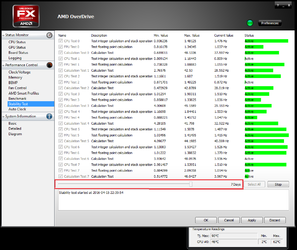I know this is last year's thread but excellent write up! Nice summary of each and very helpful to beginner overclockers (myself included). I just finished building my first gaming PC in a while. See my configuration below.
After long days of research and look around I decided to overclock my i5 7600K. My idle CPU temp is between 28-31C, and moderate load temp ~50-52C. I use CoreTemp and CPU-Z as my monitoring tools. Now, I know there are many theories on why you should keep your Vcore static but after running a couple hours on AIDA64 (averaging 66C with max 76C @1.240V-1.285V), Intel Extreme Tuning Utility or IXTU (averaging 62C with max 67C @1.230V-1.265V) and RealBench (averaging 73C with max 84C @1.230V-1.250V) separately each on adaptive voltage all @4.6GHz I find that's where I like to rest my OC for now. I use the PC mainly for moderate gaming and some multitasking jobs here and there. I rarely do any video rendering or heavy editing so I don't think I really need it over that 4.6 mark (yet). My question is, with the voltage, if it ranges from 1.230V-1.285V between the three tools,
should I really be giving my CPU that extra voltage it didn't need and make it static at say, 1.285V (max of them all) or
do I let my CPU enjoy the lower voltage when it desires?
And another thing, before using any of the other stress tools, I started my OC tests on prime95 (v28.10). Funny thing was, I could barely make it 20 secs @4.5GHz even after I crank the voltage up to 1.325V. And each time it 'fails', my PC didn't BSOD'ed or froze, it ran completely fine but it was always just that one core worker #4 coming up with the "FATAL ERROR: Rounding was 0.5, expected less than 0.4" thing. And staying true to its 'class', p95 brought the temp right up to
95-96C of which I stopped it right away and let the CPU rest for a few hours. With that high of a temperature at so low of a clock and not even that high of a voltage I refuse to believe my system was unstable so I looked up forums after forums and came across those other suggestions like AIDA64, IXTU, RB and so forth. And truly enough I got all those bracketed number said above @4.6GHz (again, AFTER that horrid test on p95) without any single problem. 1-2 hours each. And a few times over. I even left the IXTU monitoring page on while testing with AIDA64 and RB to make sure I definitely didn't have any thermal throttling. And my benchmark scores too with Cinebench R15, IXTU and RealBench are roughly in the top 10% of the whole world.
So why did p95 fail me that easily still? Some say faulty RAMs usually cause that fail, but my RAMs passed all memory stress on the other stress tools.
I think it's fair to say my rig is stable to my needs at my current overclock, right? Anyways, thanks again for the excellent post. I find some assurance reading it after the mini-heart attack p95 gave me a few nights back.

I know this is more like a general thread for stress tools but knowing that you have used all of the tools I used (and we use the same chipset!), I thought it would be appropriate to direct those questions here. Thank you!
The rig:
CPU: Intel Core [email protected] ([email protected]) Un-delidded
Motherboard: GIGABYTE Z270 Gaming K3 ATX
CPU Cooler: Cryorig A40 Ultimate Hybrid Cooler
RAM: Corsair Vangeance LPX 16GB (2x8GB) DDR4 DRAM 3000MHz
GPU: ASUS GeForce GTX 1070 8GB Dual Series O8G
Monitors: 27" ASUS Gaming LED 1440p & 23" LG Flatron LCD 1080p
Case: Phanteks Eclipse P400S Tempered Glass Glacier White Mid ATX
Fans config: Front mounted 240mm radiator intake with push configuration, 1x 120mm rear intake, 1x 120mm top exhaust
PSU: EVGA Supernova G1 650W
Storage: Samsung 250GB 850 EVO SSD & WD Blue 1TB HDD
OS: Windows 10 Home 64-bit



